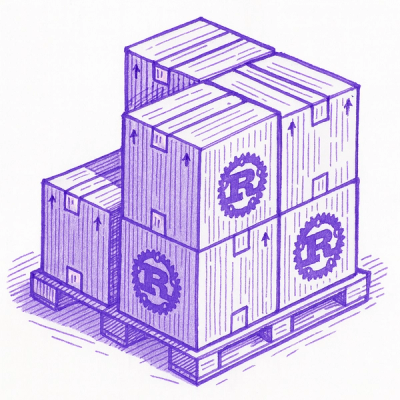
Security News
Crates.io Implements Trusted Publishing Support
Crates.io adds Trusted Publishing support, enabling secure GitHub Actions-based crate releases without long-lived API tokens.
utils-merge2
Advanced tools
Merge and extend objects.
$ npm install utils-merge2
var merge = require( 'utils-merge2' );
Merges and extends a target object.
var target = {
'a': 'beep'
};
var source = {
'a': 'boop',
'b': 'bap'
};
var out = merge( target, source );
/* returns
{
'a': 'boop',
'b': 'bap'
}
*/
The function supports merging multiple source objects.
var target = {
'a': 'beep'
};
var source1 = {
'b': 'boop'
};
var source2 = {
'c': 'cat'
};
var out = merge( target, source1, source2 );
/* returns
{
'a': 'beep',
'b': 'boop',
'c': 'cat'
}
*/
Returns a custom merge function for merging and extending objects.
var factory = require( 'utils-merge2' ).factory;
var opts = {
'level': 100,
'copy': true,
'override': true,
'extend': true
};
var merge = factory( opts );
The function accepts the following options:
level = +infinity.boolean indicating whether to deep copy merged values. Deep copying prevents shared references and source object mutation. Default: true.true, source object values will always override target object values. If false, source values never override target values (useful for adding, but not overwriting, properties). To define a custom merge strategy, provide a function. Default: true.boolean indicating whether new properties can be added to the target object. If false, only shared properties are merged. Default: true.The default merge is a deep (recursive) merge.
var target = {
'a': {
'b': {
'c': 5
},
'd': 'beep'
}
};
var source = {
'a': {
'b': {
'c': 10
}
}
};
var out = merge( target, source );
/* returns
{
'a': {
'b': {
'c': 10
},
'd': 'beep'
}
}
*/
To limit the merge depth, set the level option.
var merge = factory({
'level': 2
});
var target = {
'1': {
'a': 'beep',
'2': {
'3': null,
'b': [ 5, 6, 7 ]
}
}
};
var source = {
'1': {
'b': 'boop',
'2': {
'3': [ 1, 2, 3 ]
}
}
};
var out = merge( target, source );
/* returns
{
'1': {
'a': 'beep',
'b': 'boop',
'2': {
'3': [ 1, 2, 3 ]
}
}
}
*/
By default, merged values are deep copied.
var target = {
'a': null
};
var source = {
'a': {
'b': [ 1, 2, 3 ]
}
};
var out = merge( target, source );
console.log( out.a.b === source.a.b );
// returns false
To allow shared references, set the copy option to false.
var merge = factory({
'copy': false
});
var target = {};
var source = {
'a': [ 1, 2, 3 ]
};
var out = merge( target, source );
var bool = ( out.a === source.a );
// returns true
To prevent existing properties from being overridden, set the override option to false.
var merge = factory({
'override': false
});
var target = {
'a': 'beep',
'b': 'boop'
};
var source = {
'a': null,
'c': 'bop'
};
var out = merge( target, source );
/* returns
{
'a': 'beep',
'b': 'boop',
'c': 'bop'
}
*/
Alternatively, to define a custom merge strategy, set the override option to a function.
function strategy( a, b, key ) {
// a => target value
// b => source value
// key => object key
if ( key === 'a' ) {
return b;
}
if ( key === 'b' ) {
return a;
}
return 'bebop';
}
var merge = factory({
'override': strategy
});
var target = {
'a': 'beep',
'b': 'boop',
'c': 1234
};
var source = {
'a': null,
'b': {},
'c': 'bop'
};
var out = merge( target, source );
/* returns
{
'a': null,
'b': 'boop',
'c': 'bebop'
}
*/
To prevent non-existent properties from being added to the target object, set the extend option to false.
var merge = factory({
'extend': false
});
var target = {
'a': 'beep',
'b': 'boop'
};
var source = {
'b': 'hello',
'c': 'world'
};
var out = merge( target, source );
/* returns
{
'a': 'beep',
'b': 'hello'
}
*/
The target object is mutated.
var target = {
'a': 'beep'
};
var source = {
'b': 'boop'
};
var out = merge( target, source );
console.log( out === target );
// returns true
console.log( target.b );
// returns 'boop'
To return a new object, provide an empty object as the first argument.
var target = {
'a': 'beep'
};
var source = {
'b': 'boop'
};
var out = merge( {}, target, source );
console.log( out === target );
// returns false
Only plain JavaScript objects are merged and extended. The following values/types are either deep copied or assigned:
BooleanStringNumberDateRegExpArrayInt8ArrayUint8ArrayUint8ClampedArrayInit16ArrayUint16ArrayInt32ArrayUint32ArrayFloat32ArrayFloat64ArrayBuffer (Node.js)SetMapErrorURIErrorReferenceErrorSyntaxErrorRangeErrorSupport for deep merging class instances is inherently fragile.
Number, String, or Boolean objects are merged as primitives.
Functions are not deep copied.
var merge = require( 'utils-merge2' );
var target;
var source;
var out;
target = {
'a': 'beep',
'b': 'boop',
'c': {
'c1': 'woot',
'c2': false,
'c3': {
'c3a': [ 1, 2 ],
'c3b': null
}
},
'd': [ 1, 2, 3 ]
};
source = {
'b': Math.PI,
'c': {
'c1': 'bap',
'c3': {
'c3b': 5,
'c3c': 'bop'
},
'c4': 1337,
'c5': new Date()
},
'd': [ 4, 5, 6 ],
'e': true
};
out = merge( {}, target, source );
console.dir( out );
/* returns
{
'a': 'beep',
'b': 3.141592653589793,
'c': {
'c1': 'bap',
'c2': false,
'c3': {
'c3a': [ 1, 2 ],
'c3b': 5,
'c3c': 'bop'
},
'c4': 1337,
'c5': <Date>
},
'd': [ 4, 5, 6 ],
'e': true
}
*/
To run the example code from the top-level application directory,
$ node ./examples/index.js
This repository uses tape for unit tests. To run the tests, execute the following command in the top-level application directory:
$ make test
All new feature development should have corresponding unit tests to validate correct functionality.
This repository uses Istanbul as its code coverage tool. To generate a test coverage report, execute the following command in the top-level application directory:
$ make test-cov
Istanbul creates a ./reports/coverage directory. To access an HTML version of the report,
$ make view-cov
This repository uses Testling for browser testing. To run the tests in a (headless) local web browser, execute the following command in the top-level application directory:
$ make test-browsers
To view the tests in a local web browser,
$ make view-browser-tests
Copyright © 2015-2016. Athan Reines.
FAQs
Merge and extend objects.
We found that utils-merge2 demonstrated a not healthy version release cadence and project activity because the last version was released a year ago. It has 1 open source maintainer collaborating on the project.
Did you know?

Socket for GitHub automatically highlights issues in each pull request and monitors the health of all your open source dependencies. Discover the contents of your packages and block harmful activity before you install or update your dependencies.

Security News
Crates.io adds Trusted Publishing support, enabling secure GitHub Actions-based crate releases without long-lived API tokens.

Research
/Security News
Undocumented protestware found in 28 npm packages disrupts UI for Russian-language users visiting Russian and Belarusian domains.

Research
/Security News
North Korean threat actors deploy 67 malicious npm packages using the newly discovered XORIndex malware loader.